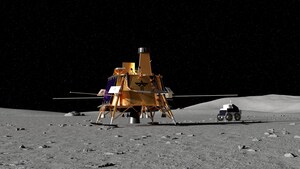NASA Completes Critical Design Review of One Landsat Instrument
GREENBELT, Md., May 26 /PRNewswire-USNewswire/ -- NASA engineers have begun building hardware for a new Landsat satellite instrument that helps monitor water consumption — an important capability in the U.S. West where precipitation is sparse and water rights are allocated — now that they have passed an independent review of the instrument's design and integration and testing methods.
(Logo: http://www.newscom.com/cgi-bin/prnh/20081007/38461LOGO )
"Having received the green light on our design during NASA's Critical Design Review, we are moving out on full implementation of our instrument," said Cathy Richardson, the instrument manager of the Thermal Infrared Sensor (TIRS), which will be built at the Goddard Space Flight Center in Greenbelt, Md.
TIRS is one of two instruments flying on the Landsat Data Continuity Mission (LDCM), the next generation in a series of satellites that have provided multispectral data of Earth's surface for more than 38 years. TIRS and the Operational Land Imager (OLI), being built by Ball Aerospace & Technologies Corp in Boulder, Colo., will extend Landsat's unparalleled record of Earth's changing landscapes.
NASA plans to launch LDCM in December 2012 as the follow-on to Landsat-7, launched in 1999. Landsat 7 and 5, launched in 1984, are continuing to supply images and operating beyond their design lives. As with preceding Landsat missions, the U.S. Geological Survey (USGS) will operate LDCM and maintain its data archive once it begins observations.
The 236-kg (525-lb.) TIRS is a two-channel thermal imager, providing 100-meter (328 feet) spatial resolution across a 185 km (115 mile) field-of-view. Both Landsats-5 and -7 provide thermal data, and the addition of TIRS will extend the Landsat database in the thermal infrared bands needed by a variety of users.
Thermal data are used operationally to monitor such things as water consumption on a field-by-field basis in the U.S. West mainly for agricultural purposes, said LDCM project scientist Jim Irons. TIRS will continue providing surface-temperature readings considered vital in a technique that resource managers in Idaho and other western states use to measure water use through evapotranspiration. As its name implies, evapotranspiration combines the evaporation of water into the atmosphere and the water vapor released by plants through respiration. "A transpiring plant is cooler than the surrounding area," Irons said. "If a forest is dry, it will not transpire and it will be warmer."
Western resource managers see the measurement technique as the most effective way to determine who is consuming water because it more accurately defines how much water is being removed from the system by a given individual or entity. Since adopting the technique, which its developers call METRIC for Mapping EvapoTranspiration with High Resolution and Internalized Calibration, resource managers report that the technique has helped resolve conflicts over water consumption among farmers irrigating their fields.
Landsat thermal data also are used to map urban heat fluxes for air-quality monitoring, assess volcano hazards, detect and screen clouds, track lake thermal plumes from power plants, map burn areas and assess wildfire risks, and identify mosquito-breeding areas.
TIRS will provide the infrared surface-temperature data with high-sensitivity, cryogenically cooled, Quantum Well Infrared Photodetector (QWIP) arrays, a detector technology that Goddard engineer Murzy Jhabvala developed over nearly two decades. With various funding sources, Jhabvala had matured the technology and had even created years earlier a one-million-pixel array that could sense a range of longer wavelength bands — more robust than the TIRS requirement of 10.5 to 12.5 micrometers. TIRS is the first spaceflight instrument to use the technology.
"Instrument developers selected the QWIP technology because it could easily meet the instrument's performance requirements and production schedule," Jhabvala said, adding that he and his team began working on the detector system in July 2008.
In particular, TIRS will carry three 640 x 512 QWIP arrays that are made of Gallium Arsenide semiconductor chips layered with more than 100 layers of detector material. The layers act as quantum wells, which trap electrons — the fundamental particles that carry an electric current — so that only light with a specific energy can release them. If the light with the correct energy hits one of the quantum wells in the array, the freed electron flows through a separate readout chip above the array where it is recorded. A computer uses this information to create an image of the infrared source. Fabricators can build a detector to sense specific wavelength bands by varying the composition and thickness of the layers.
Jhabvala and his team qualified the technology for actual spaceflight last August, and plan to deliver the detector system this November for integration into the instrument.
For more information on the LCDM, visit:
SOURCE NASA
WANT YOUR COMPANY'S NEWS FEATURED ON PRNEWSWIRE.COM?
Newsrooms &
Influencers
Digital Media
Outlets
Journalists
Opted In





Share this article